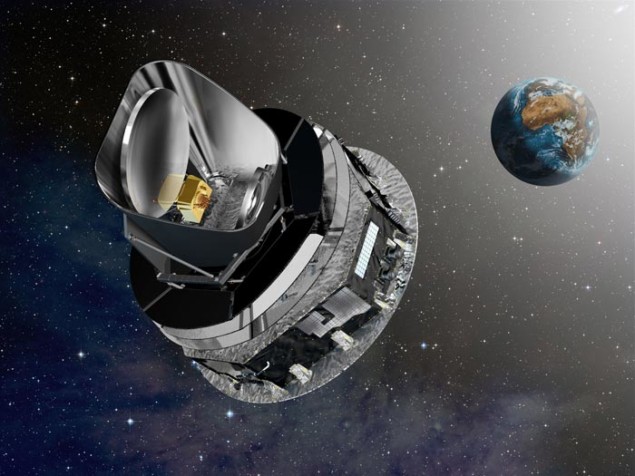
Evidence of supersymmetry (SUSY) could be lurking in the cosmic microwave background (CMB), according to a UK-based physicist who has calculated how the theory could affect fluctuations in the CMB. The claim comes just a few days after the latest CMB observations were released by the team running the Planck space telescope – results that suggest that evidence for SUSY may not be forthcoming from the CMB. However, if these latest calculations are correct, the CMB could offer a window into dark matter and complement the search for SUSY at the Large Hadron Collider (LHC) when it starts up again in 2015.
Back in March, the team behind the European Space Agency’s Planck telescope released the most accurate map to date of the cosmic microwave background (CMB) – the relic radiation left over from the Big Bang. As well as putting tighter constraints on the age of the universe and its contents, the findings also strongly support the idea that the early universe underwent a rapid growth spurt known as inflation. In the first tiny fraction of a second, the infant universe swelled by a factor of 1078. Physicists’ simplest explanation is that a single field – the inflaton – provided the mechanism for this exponential increase. Natural quantum fluctuations within the inflaton would have been blown up too and are now imprinted as the speckled temperature variations seen in Planck’s CMB map.
Imprinted by sparticles?
However, some researchers working on theories that go beyond the Standard Model of particle physics believe that the inflaton would have had other fields for company. SUSY encompasses one such family of theories and postulates that every known particle has an as-yet-unseen partner known as a “superparticle” or “sparticle”. Each sparticle has a corresponding field that should have been present in the universe’s first moments, and therefore could also be imprinted in the CMB.
Now, Anupam Mazumdar of Lancaster University has set out to explore this idea further, telling physicsworld.com, “A natural question one can ask is what do these [additional] fields do in the early universe?”
In trying to answer this, he hit upon a new idea. “It is possible the extra fields play the role of spectators, unable to modify the dynamics of inflation but still leaving an imprint,” he explains. He calculates that fluctuations within these spectator fields would have been much larger than those of the inflaton. As the universe swelled, they got taken along for the ride. It could be, then, that it is these spectator fields, and not the inflaton, that are responsible for the speckles in the CMB map. The key test is in how the speckles are distributed. “If they are caused by fluctuations in multiple fields then their distribution [throughout the CMB map] would not be exactly Gaussian,” says Mazumdar, referring to the bell-shaped curve ubiquitous in statistics.
Still room for new physics
However, there is a snag. Mazumdar’s initial work was published in Physical Review D prior to the release of the Planck findings, which have since shown the distribution to be closer to Gaussian than ever previously measured. Re-examining his work in light of Planck, he posted a new paper on the arXiv pre-print server. “I had to rule out some parameters, but there is still space in there for new physics,” he argues. Speaking to physicsworld.com ahead of a recent Planck conference in the Netherlands, he says he will present evidence that “multiple fields might play the same role as a single field, within the range that Planck has shown”.
Currently, it is difficult to tell one way or the other, but any departure from a Gaussian distribution in the CMB would leave the door open to SUSY. “Planck has diminished the possibility of a link, but it hasn’t destroyed it,” explains Andrew Pontzen of the University of Oxford, who was not involved in the research. “We’ll need future experiments like the Square Kilometre Array, but if a link can be teased out between inflation physics and supersymmetry that would be tremendously exciting,” he said.
Whither the WIMPs?
Part of the excitement stems from the possibility of explaining dark matter, the shadowy entity that the Planck result revealed to make up almost 27% of the mass/energy of the universe. Although physicists do not know exactly what dark matter is, some supersymmetry theories predict the existence of weakly interacting massive particles (WIMPs), which are a leading candidate for dark matter. “We’re closing in on WIMPs with experiments like the Large Hadron Collider, so if you could also make a link to the period of inflation, that would allow us to tackle the problem from two angles,” explains Pontzen.
But, with the Square Kilometre Array not due to come online until 2020, and the LHC recently shut down for refurbishment, Mazumdar’s idea of physics beyond the Standard Model playing a role in inflation may, for now, remain a tantalizing possibility.



